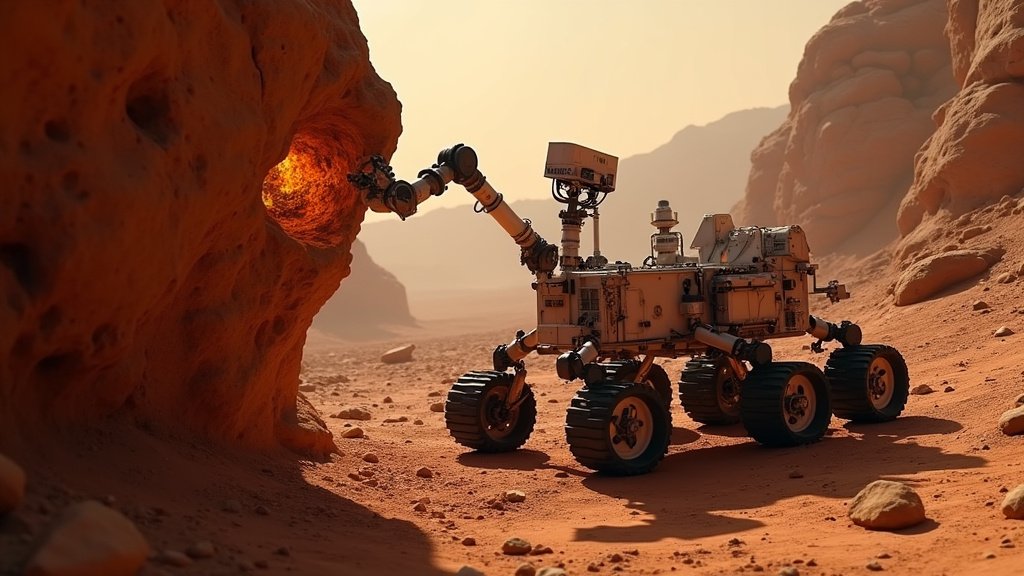In a discovery poised to redefine our understanding of life beyond Earth, NASA announced on September 10, 2025, that its Perseverance rover has found compelling evidence suggesting ancient microbial life once existed on Mars. The groundbreaking findings, detailed in a recent publication in the journal Nature, stem from an analysis of a rock sample collected from Jezero Crater, presenting what scientists are calling the most significant hints to date of past biological activity on the Red Planet.
Unearthing ‘Sapphire Canyon’ in Jezero Crater
The focal point of this historic announcement is a rock sample nicknamed “Sapphire Canyon,” meticulously drilled from a larger rock formation named “Cheyava Falls.” This particular rock was located within the “Bright Angel” formation, a geological area situated on the western edge of Jezero Crater. Jezero Crater itself has long been a prime target for astrobiological research, as evidence indicates it was once a vast lakebed fed by a river delta billions of years ago – an environment potentially conducive to life as we know it.
The Perseverance rover, which landed in Jezero Crater in February 2021, has been systematically exploring this ancient landscape, analyzing rock and sediment to uncover clues about Mars’ geological history and potential for past habitability. The “Sapphire Canyon” sample was collected in 2024, and extensive analysis has followed, culminating in this significant announcement.
The Intriguing ‘Leopard Spots’ and Chemical Signatures
What makes the “Sapphire Canyon” sample so remarkable are its distinctive “leopard spots” – intricate patterns of minerals arranged into reaction fronts. High-resolution images and data from Perseverance’s sophisticated instruments, including PIXL and SHERLOC, revealed that these spots are rich in specific iron-based minerals: vivianite (a hydrated iron phosphate) and greigite (an iron sulfide). Alongside these mineral signatures, the rover detected organic carbon, sulfur, oxidized iron (rust), and phosphorus within the rock’s clay and silt-rich mudstone composition.
On Earth, such combinations of minerals and organic compounds, particularly when arranged in these specific patterns, are frequently associated with microbial metabolisms. Microorganisms often utilize electron-transfer reactions between sediment and organic matter to derive energy for their growth. The presence of these features in the Martian rock suggests that similar processes could have occurred billions of years ago.
A Potential Biosignature, But Not Definitive Proof
NASA scientists emphasize that these findings represent potential biosignatures – characteristics that could have a biological origin but require further investigation before a definitive conclusion can be reached. While the mineral patterns and chemical composition are highly suggestive and represent the “closest we have ever come to discovering life on Mars,” according to acting NASA Administrator Sean Duffy, non-biological processes cannot yet be entirely ruled out. Scientists acknowledge that natural geological processes can sometimes mimic biological ones, especially under Martian conditions.
However, the research team’s extensive “pressure testing” and analysis over the past year have reportedly found no particularly strong evidence for alternative abiotic explanations. The co-occurrence of organic matter with these redox-sensitive minerals is particularly compelling, suggesting that organic molecules may have played a role in driving the chemical reactions that formed these minerals.
Implications for Mars’ Ancient Habitability
One of the surprising aspects of this discovery is the age of the rock formation. The “Bright Angel” formation is composed of some of the younger sedimentary rocks that Perseverance has analyzed. Previously, it was widely hypothesized that any definitive signs of ancient life would likely be preserved in much older geological layers. This finding suggests that Mars may have retained habitable conditions later in its history than previously understood.
A Landmark in the Search for Extraterrestrial Life
The Perseverance rover’s findings from “Sapphire Canyon” are a pivotal moment in the ongoing quest to explore for life beyond Earth. The data gathered is now accessible to the global scientific community, encouraging further study and debate. Ultimately, the confirmation of these potential biosignatures may hinge on the analysis of returned samples on Earth, a crucial next step in Mars exploration. This discovery not only advances our knowledge of Mars’ past but also fuels the enduring human curiosity to answer the question: Are we alone in the universe? This news is trending globally as scientists explore the vast implications for astrobiology, and the public can enjoy following this monumental scientific journey.





